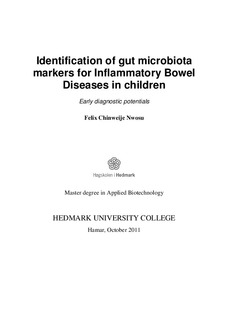| dc.description.abstract | There are a growing body of evidences that the human gut microbiota is involved in the pathogenesis of inflammatory bowel diseases (IBD). Two mains forms exists, namely Crohn’s disease (CD) and Ulcerative Coilitis (UC). Although these knowledge are so far limited, a better understanding of the gut microbes and variations in health and disease can contribute to inflammatory bowel disease diagnotics. In this current project as reported, was designed to determine correlations between the composition of the gut microbiota and IBD in children (less than 18 years old) and thus evaluate potentials for early diagnostics. From a repertoire of faecal specimens from early diagnosed IBD (CD and UC) and non-IBD controls at Akershus University Hospital bio-bank, 75 children samples were analysed utilising bacterial small subunit (SSU) rRNA as biomarkers. DNA from this samples were extracted and purified using the QIAGEN QIAamp® DNA Stool Kit. Using a combination of forward and reverse primers that generally target the conserved regions of 16S rRNA gene of multiple microorganisms, the amplicons were direct sequenced. The mixed pool of sequences were subjected to multivariate curve resolution with resulting five components matched by Ribosomal Database Project search to, Faecalibacterium, Dialister, Haemopilus, Enterobacteriaceae and Bacteroides as dominant phylotypes and corresponding frequencies in all samples were obtained. To isolate pure bacterial species within the cohort, MCR selected samples were cloned into plasmid vectors of competent E. coli cells (TOPO®TA Cloning Kit) and sequenced. The clone library revealed earlier enumerated bacterial species in IBD cases against controls in literature and as well as Haemophilus, a previously uncharacterised gut bacteria. Similary, the clone library sequences were subjected to the Genetic Analysis (GA) in house probe design programme with specific settings that would generally label targets, excluding non-targets at the set conditions were screened on the cohort samples 16S rRNA amplicons utilising the GA two step single nucleotide extension (SNE) novel probe technology. In addition to six probes being screen, a Universal probe was screened for normalisation.
To establish correlation to disease, data generated from both multivariate resolution and probe screening was put through the SYSTAT binary logistic regression model. The MCR prediction showed Faecalibacterium and Enterococcus significantly correlating to disease, IBD and UC respectively. However, the selective probes showed specificity to Dialister and Haemophilus clusters, correlating to UC and CD respectively and hence the diagnostic potentials proposed. The finding in this study may have wider impimplication for early IBD diagnostic if followed up with extensive validation. | no_NO |
